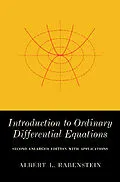Introduction to Ordinary Differential Equations, Second Edition provides an introduction to differential equations. This book presents the application and includes problems in chemistry, biology, economics, mechanics, and electric circuits. Organized into 12 chapters, this edition begins with an overview of the methods for solving single differential equations. This text then describes the important basic properties of solutions of linear differential equations and explains higher-order linear equations. Other chapters consider the possibility of representing the solutions of certain linear differential equations in terms of power series. This book discusses as well the important properties of the gamma function and explains the stability of solutions and the existence of periodic solutions. The final chapter deals with the method for the construction of a solution of the integral equation and explains how to establish the existence of a solution of the initial value system. This book is a valuable resource for mathematicians, students, and research workers.
Inhalt
Preface
I Introduction to Differential Equations
1.1 Introduction
1.2 Separable Equations
1.3 Exact Equations
1.4 First-Order Linear Equations
1.5 Orthogonal Trajectories
1.6 Decay and Mixing Problems
1.7 Population Growth
1.8 An Economic Model
1.9 Cooling: The Rate of a Chemical Reaction
1.10 Two Special Types of Second-Order Equations
1.11 Falling Bodies
References
II Linear Differential Equations
2.1 Introduction
2.2 Linear Dependence
2.3 Wronskians
2.4 Polynomial Operators
2.5 Complex Solutions
2.6 Equations with Constant Coefficients
2.7 Cauchy-Euler Equations
2.8 Nonhomogeneous Equations
2.9 The Method of Undetermined Coefficients
2.10 Variation of Parameters
2.11 Simple Harmonic Motion
2.12 Electric Circuits
2.13 Theory of Linear Equations
References
III Series Solutions
3.1 Power Series
3.2 Taylor Series
3.3 Ordinary Points
3.4 Regular Singular Points
3.5 The Case of Equal Exponents
3.6 The Case When the Exponents Differ by an Integer
3.7 The Point at Infinity
3.8 Convergence of the Series
References
IV Bessel Functions
4.1 The Gamma Function
4.2 Bessel's Equation
4.3 Bessel Functions of the Second and Third Kinds
4.4 Properties of Bessel Functions
4.5 Modified Bessel Functions
4.6 Other Forms for Bessel's Equation
References
V Orthogonal Polynomials
5.1 Orthogonal Functions
5.2 An Existence Theorem for Orthogonal Polynomials
5.3 Properties of Orthogonal Polynomials
5.4 Generating Functions
5.5 Legendre Polynomials
5.6 Properties of Legendre Polynomials
5.7 Orthogonality
5.8 Legendre's Differential Equation
5.9 Tchebycheff Polynomials
5.10 Other Sets of Orthogonal Polynomials
Table of Orthogonal Polynomials
References
VI Eigenvalue Problems
6.1 Introduction
6.2 Self-Adjoint Problems
6.3 Some Special Cases
6.4 Singular Problems
6.5 Some Important Singular Problems
References
VII Fourier Series
7.1 Introduction
7.2 Examples of Fourier Series
7.3 Types of Convergence
7.4 Convergence in the Mean
7.5 Complete Orthogonal Sets
7.6 Pointwise Convergence of the Trigonometric Series
7.7 The Sine and Cosine Series
7.8 Other Fourier Series
References
VIII Systems of Differential Equations
8.1 Introduction
8.2 First-Order Systems
8.3 Linear Systems with Constant Coefficients
8.4 Mechanical Systems
8.5 Electric Circuits
8.6 Some Problems from Biology
References
IX Laplace Transforms
9.1 The Laplace Transform
9.2 Conditions for the Existence of the Laplace Transform
9.3 Properties of Laplace Transforms
9.4 Inverse Transforms
9.5 Applications to Differential Equations
References
X Partial Differential Equations and Boundary Value Problems
10.1 Introduction
10.2 The Heat Equation
10.3 The Method of Separation of Variables
10.4 Steady-State Heat Flow
10.5 The Vibrating String
10.6 The Solution of the Problem of the Vibrating String
10.7 The Laplacian in Other Coordinate Systems
10.8 A Problem in Cylindrical Coordinates
10.9 A Problem in Spherical Coordinates
10.10 Double Fourier Series
References
XI The Phase Plane
11.1 Introduction
11.2 Stability
11.3 The Method of Liapunov
11.4 Perturbed Linear Systems
11.5 Periodic Solutions
References
XII Existence and Uniqueness of Solutions
12.1 Preliminaries
12.2 Successive Approximations
12.3 Vector Functions
12.4 First-Order Systems
References
Appendix
A1 Determinants
A2 Properties of Determinants
A3 Cofactors
A4 Cramer's Rule
Answers to Selected Exercises
Subject Index
